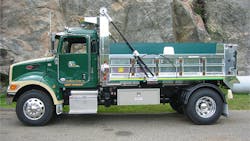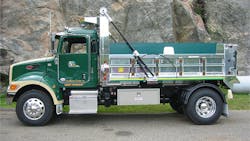So Just What is a Work Truck?
We’ve been writing about The Work Truck Show for the last several years because most work trucks incorporate some sort of fluid power. Truck-mounted cranes, snow plows, and street cleaners are examples of work trucks, but they don’t define the term.
So let’s go to the authority, NTEA: The Association for the Work Truck Industry. The NTEA is composed of nearly 1,800 companies that manufacture, distribute, install, sell, and repair commercial trucks, truck bodies, truck equipment, trailers, and accessories. According to Steve Carey, executive director of NTEA, “Unlike mass-produced assembly-line cars and trucks, commercial vehicles are primarily designed and produced individually, on a custom-order basis. Their diverse applications, limited volume, and nearly limitless body and equipment variations dictate this method of production.”
Carey explained that commercial trucks typically are built in a multi-stage process involving distinct, yet interrelated industry segments. To ensure compatibility with the application, a close-working relationship is necessary between the truck chassis and engine manufacturers and truck body, equipment, and trailer manufacturers. Dealers and distributors play an essential role in this interaction.
In many cases, construction of a work truck begins with one of several standard chassis manufactured by Ford, GMC, Mack, etc. In many cases, the chassis also comes with a cab, so the work truck manufacturer installs its equipment onto the vehicle frame. Depending on the equipment, it may have its own power source, or a power takeoff may tap into the transmission to drive a hydraulic pump or compressor. A truck-mounted crane, maintenance vehicle, or garbage truck may fall into this category.
As work trucks become more specialized, though, the frame is built to specifications, and an engine is selected that closely matches the power requirements and available space in the engine compartment. This is where hydraulics may become more integral to the machine. The engine’s bell housing may contain gears for driving one or more hydraulic pumps in addition to or instead of a mechanical drive train.
How vast is the U.S. work truck industry? According to Steve Latin-Casper, director of the market data and research at NTEA, work truck shipments in 2014 reached $121.8 billion. This includes the value of shipments for all commercial truck chassis, truck bodies, trailers, buses, firefighting and other rescue vehicles, and truck equipment as compiled by the U.S. Bureau of the Census.
Most surprising, though, was the breadth of applications for work truck. Naturally, we’d consider any over-the-road truck with a hydraulic or pneumatic system for work functions to be a work truck. But the airport van that takes you to and from the rental car lot is also a work truck. So are school buses. This makes it much less surprising of the economic impact of the work truck industry.


